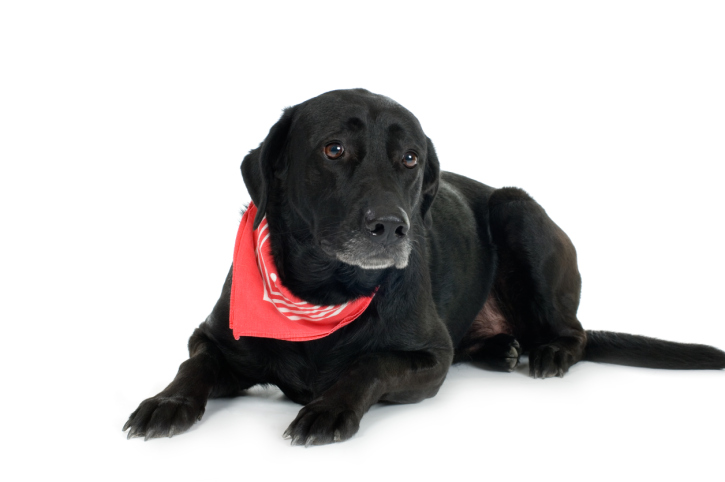by Dr. David Erlewein, DVM
Grizz is the sweetest, calmest, most trustworthy Labrador in the world until it comes to food! Then he becomes a master countersurfer and the ultimate sneak thief. So, no one was surprised when in an unguarded moment Grizz got an entire medium, double cheese, three-meat pizza! Nor was anyone surprised when Grizz vomited a great greasy glob with some identifiable chunks of pepperoni an hour after the crime. The next morning, however, Grizz’s humans were surprised and very concerned. The dog everyone thought had an iron stomach was sick – very sick!
When I examined Grizz he had a fever of 105.4 degrees. His abdomen was as tight as a drum head, and he would moan and wince with the slightest touch. He had vomited multiple times during the night, and this morning had explosive diarrhea at home and in the car on the way to the clinic. This was a bad day for both Grizz and his humans. For the first time in his life, Grizz had no interest in food!
I told Grizz’s humans that I was suspicious he had acute pancreatitis, and we needed to run some blood work and take some X-rays of his abdomen. A short time later, the diagnosis was confirmed. The X-rays ruled out bloat and intestinal obstruction, and the blood tests revealed an elevated white blood cell count and four-fold elevations of the pancreatic enzymes amylase and lipase. Most importantly, a relatively new test called specific canine pancreatic lipase was positive. This test excludes other conditions 98 percent of the time and is positive in more than 80 percent of pancreatitis cases.
The pancreas is a skinny little glandular organ tightly adhered to the first portion of the small intestine where it connects to the stomach. It has two main functions: the production of enzymes necessary for digestion of food and the production of insulin and glucagon to regulate sugar metabolism. The enzymes are released into the small intestine through a duct called the pancreatic duct.
In pancreatitis, the organ becomes inflamed, which releases enzymes that are normally stored in granules within the pancreas. The release of these enzymes results in digestion of pancreatic tissue, causing further inflammation and tissue damage or actual tissue death. Toxins are released with widespread body inflammation. The liver is often affected as it is very close to the pancreas, and if the ability of the pancreas to produce insulin is affected, temporary or permanent diabetes can occur. Pancreatitis can also cause severe widespread destruction of body fats, which is very painful and causes brain damage if the fats protecting the nervous system are involved. One of the most disastrous effects of pancreatitis is a condition called disseminated intra-vascular coagulation or DIC. DIC results in abnormal bleeding and clotting throughout the body, which can be fatal. While the majority of the time the inflammation of pancreatitis is confined to the pancreas and liver, the condition is still painful and serious. Even a seemingly mild case can become life-threatening. Pancreatitis can be acute or chronic and range from mild to severe.
Most of the time, we never really know what caused the inflammation, but there are some known predisposing factors and activities that can result in pancreatitis. Nutritional factors such as high fat diets or ingestion of large quantities of fat can cause abnormally high levels of fat in the blood and/or reflux of intestinal fluids back into the pancreatic duct and pancreas. Blockage of the pancreatic duct by tumors of the intestine or pancreas can also cause the disease, as can trauma to the pancreas from injury or manipulation during surgery. Other predisposing causes include disorders such as diabetes and hypothyroidism, and some drugs and insecticides. Though cocker spaniels, schnauzers, and poodles are at a higher risk for pancreatitis, the disorder can develop in any breed of dog.
Treatment of pancreatitis often involves hospitalization and intensive intravenous fluid administration. During treatment we do not want to stimulate the pancreas in any way, so no food is given orally and vomiting often precludes the dog keeping even water down. Intravenous feeding for two or more days is usually necessary. As pain is a prominent feature of the disorder, pain control is important for both comfort and resolution of the inflammation. Drugs to control vomiting are essential, and antibiotic are often given as infection with intestinal bacteria is a common development.
Once the patient is able to resume eating, a low fat, high fiber diet is used to reduce stimulation of the pancreas. Some scarring or permanent damage to the pancreas nearly always results from acute pancreatitis. Thus, some dogs need long term use of a high fiber, low fat diet. Recovered dogs should be watched for the development of diabetes.
As for Grizz, he is fully recovered with no apparent long-term damage but unfortunately has not learned from his experience. He is still a countersurfer supreme, and his “staff” is always on high alert when food is being prepared, served, consumed, or put away.







